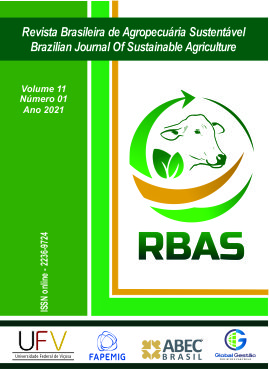Escape behavior of Folsomia candida exposed to soil contaminated with ametryn
DOI:
https://doi.org/10.21206/rbas.v11i1.12536Keywords:
Ecotoxicology, Collembola, ametrynAbstract
Brazil is among the countries that most consume pesticides in the world. From 2019 to June 2020, 653 new pesticides were registered, the highest number of releases ever seen. In 2020, 343 new products were registered and using edaphic fauna as bioindicators of soil quality are of great importance to understand the effects that these pesticides can cause on organisms, which can alter the stability of ecosystems, since it is in the soil where the edaphic fauna maintains fundamental ecological processes. One of the pesticides used in large Brazilian monocultures is the herbicide ametrine, Class III toxicological classification, moderately toxic, used in sugarcane, coffee and other crops. The aim of this work was to study the effect of applying different doses of ametrine and to evaluate the flight behavior of Folsomia candida species. Four concentrations of ametrine were used plus the control in triplicate, in a red latosol. The distribution of the individuals remained within the range of 40 to 60% in the double control, in this case, 50% and the mortality of the collemboli was less than 20%. The leaking of the collembols occurred already in the first dose of ametrine (2,8 ?l/kg of dry soil) and in the maximum dose (22,2 ?l/kg of dry soil) it obtained the highest percentage of leak, 46.6%. No leakage percentage greater than or equal to 80% was found that demonstrates toxicity, however the organisms preferred the control soil in most samples, 62.71%, indicating an alert of possible toxicity. According to Fisher's test, no significant difference was found even if leakage was observed. Even though no toxicity has been demonstrated in this study, further studies are needed to promote results that show the impact that these assets can cause in the reproduction of this and other non-target species, the health of the environment and, consequently, human health.
Downloads
Downloads
Published
How to Cite
Issue
Section
License
Copyright (c) 2021 Brazilian Journal of Sustainable Agriculture

This work is licensed under a Creative Commons Attribution-NonCommercial-NoDerivatives 4.0 International License.
1. Proposta de Política para Periódicos de Acesso Livre
Autores que publicam nesta revista concordam com os seguintes termos:
Autores mantém os direitos autorais e concedem à revista o direito de primeira publicação, com o trabalho simultaneamente licenciado sob a Licença Creative Commons Attribution que permite o compartilhamento do trabalho com reconhecimento da autoria e publicação inicial nesta revista.











